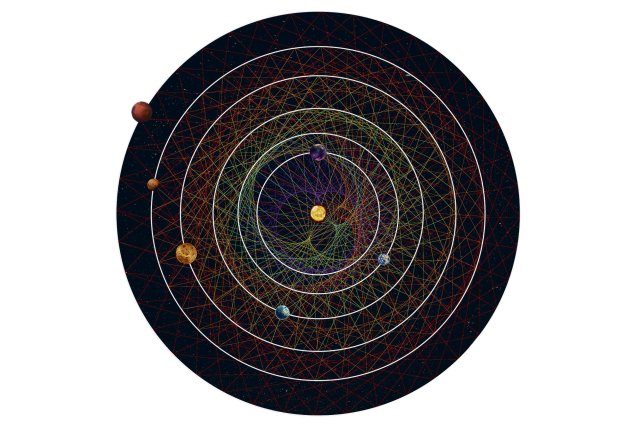Patterns in space: The resonance chain of the six planets of star HD 110067
Photo: Thibaut Roger/NCCR PlanetS, CC BY-NC-SA 4.0
Astronomers have discovered a six-pack – always a refreshing sight in the nearby refrigerator, but in the case of the star HD 110067, which is around 100 light-years away, a pretty “hot” discovery. The cosmic six-pack is not only an already rare system with six planets, all a little smaller than Neptune, but the planetary orbits also correlate in a very special way.
NASA’s TESS (Transiting Exoplanet Survey Satellite) space telescope uses the transit method to discover exoplanets from Sun-like and slightly less bright stars within 30 to 300 light-years. The method detects exoplanets indirectly: If an exoplanet passes in front of its central star in its orbit, the brightness of the star decreases by a tiny fraction during the passage – often considerably less than one percent. Since other phenomena, such as a restless flickering of the star or the appearance of “sunspots”, can also cause a change in brightness, it is generally accepted that only three observed transits mean that a new planet has been found.
The TESS observation area was divided into a total of 26 overlapping sections of the sky, so-called sectors, each of which was observed for almost a month. The spatial overlap also increased the likelihood of observing planets with longer orbital periods.
HD 110067 and its planetary system were discovered in a first “sector observation” by TESS in 2020. Several decreases in brightness seemed to indicate two exoplanets – but it was only with further images of the star in 2022 and nine additional decreases in brightness that astronomers were able to determine the first orbital parameters with certainty. Accordingly, the innermost exoplanet races around its central star in a good nine days, while another takes 13.7 days to complete one orbit. However, all recorded brightness minimums could not yet be explained by a planetary double pack.
Precise analyzes of the brightness minima always provide information about other planetary properties, including radius and density, the nature of its possible atmosphere or even characteristics of the orbit. However, in large sky surveys that are used to find exoplanets for the first time, the observation time for a single star is limited. If a planetary system needs to be examined more closely, other telescopes are used – such as CHEOPS (CHaracterizing ExOPlanet Satellite). The ESA space telescope examines stars with exoplanets that have already been reliably identified using high-precision photometry, thereby eliciting further information from distant worlds. In the case of HD 110067, CHEOPS provided enough data to locate planet number 3 in its 20-day orbit.
The orbital times determined in this way made it possible for the first time to draw conclusions about a special property of the system. The times in which the planets orbit the star are in an integer ratio with their respective neighbors; they form “orbital resonances”: In the time in which the innermost planet completes three orbits (a good 27 days), its neighbor has the star circled exactly twice. And the same 3:2 ratio also exists between the second and third planets.
Now models of the formation of planetary systems indicate that such “harmonic” conditions have stabilizing properties and that every system could initially have resonant orbital conditions. Over the course of billions of years, however, disruptors, such as a passing star or an impact event, can increasingly disrupt the order. A planetary system like that of HD 110067 would not only be a particularly original “fossil” – the possible harmony was also used as an approach to explain the as yet unexplained fluctuations in brightness. Astronomers investigated the possibility that the star’s luminosity minima could be associated with planets that continue the “resonance chain.” Three more “planetary beads” would have to be threaded with orbital periods of just under 31, 41 and 55 days – which is actually in excellent agreement with the data sets and can explain the dips in brightness observed so far.
Other planets that are also harmonious and have orbital periods of more than 70 days cannot be ruled out. However, these have not yet been found due to the short observation times. It would then even be possible for these companions to lie in the so-called “habitable zone” of the star, the area in which liquid water can be permanently present. On the planets discovered so far, referred to as HD 110067 bg according to the usual nomenclature, the surface temperature is a little more than just summery, with a surface temperature of around 170 to 530 degrees Celsius.
By the way, in 2021, the planetary system around TOI-178 would have almost achieved a similar feat. The 200 light-years away star, also observed by TESS and CHEOPS, is also orbited by six planets: two Earth-like near the star, four Neptune-like gas planets further out. And for five of them everything runs really resonantly – only the innermost one seems a little tipsy and runs a little too slowly…
#ndstays – Get active and order a promotional package
Regardless of whether it is pubs, cafés, festivals or other meeting places – we want to become more visible and reach everyone who values independent journalism with an attitude. We have put together a campaign package with stickers, flyers, posters and buttons that you can use to get active and support your newspaper.
To the promotional package
